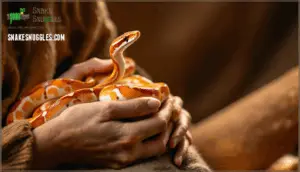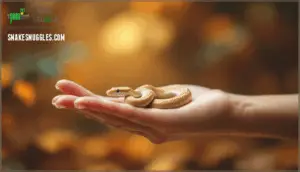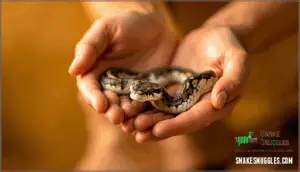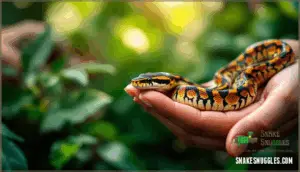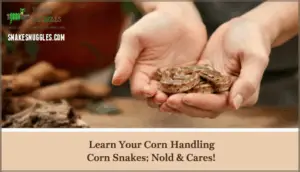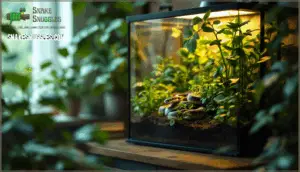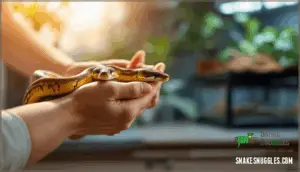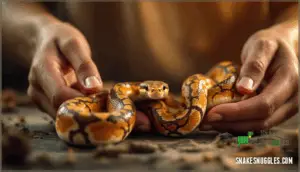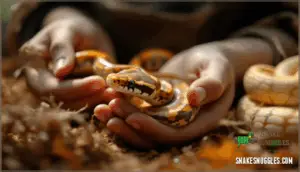This site is supported by our readers. We may earn a commission, at no cost to you, if you purchase through links.
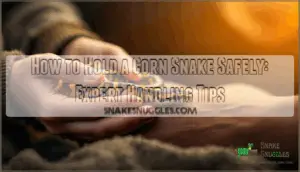 Your new corn snake is coiled in its enclosure, watching you with curious eyes. But reach in too soon or grab it the wrong way, and you’ll quickly learn that even these gentle snakes have limits. The difference between a calm, touchable pet and a defensive, stressed-out snake often comes down to timing and technique.
Your new corn snake is coiled in its enclosure, watching you with curious eyes. But reach in too soon or grab it the wrong way, and you’ll quickly learn that even these gentle snakes have limits. The difference between a calm, touchable pet and a defensive, stressed-out snake often comes down to timing and technique.
Most beginners make the same mistakes—touching too early, gripping too tight, or missing the warning signs that their snake needs space. Getting it right from the start makes all the difference in building trust with your corn snake.
Table Of Contents
- Key Takeaways
- When Can I Start Handling My Corn Snake?
- How Often and How Long Should I Handle?
- How to Pick Up a Corn Snake Safely
- Proper Techniques for Holding Your Corn Snake
- When Shouldn’t I Hold My Corn Snake?
- How to Build Trust and Tame Your Corn Snake
- How Can I Avoid Being Bitten While Handling?
- What to Do if Your Snake Feels Threatened
- Frequently Asked Questions (FAQs)
- Conclusion
Key Takeaways
- Wait at least 2-3 weeks after bringing your corn snake home and let it eat two meals before attempting any handling, since rushing this settling period causes unnecessary stress and defensive behavior.
- Hold your snake with both hands supporting its middle sections (never grab the head or tail), using slow, predictable movements while letting it move naturally through your hands to keep it feeling secure and relaxed.
- Skip handling entirely for 48 hours after feeding and during shedding periods, and immediately return your snake to its enclosure if you see stress signals like S-shaped coiling, hissing, or rapid tongue flicking.
- Start with brief 5-minute sessions once or twice weekly, then gradually increase to 10-15 minutes as your snake becomes comfortable, watching its body language to know when you’ve hit its interaction limits.
When Can I Start Handling My Corn Snake?
You can’t just grab your new corn snake the moment you unbox it. Your snake needs time to settle in, show signs of comfort, and establish a basic feeding routine before you start building that hands-on connection.
Let’s walk through the timing, the signals to watch for, and how to set yourself up for success from day one.
Settling-in Period After Arrival
Patience is your first job as a new corn snake owner, and it starts the moment your snake arrives home. Your snake needs time to adjust before any manipulation techniques can come into play. During this acclimation period, your snake is dealing with environmental adjustments and stress from the move.
Here’s what to do during the initial care phase:
- Wait 2-3 weeks before attempting corn snake manipulation
- Let your snake eat at least two meals in its new home
- Avoid disturbing the enclosure except for essential care
This acclimation time prevents snake stress and sets the foundation for secure manipulation and stress-free interaction later.
Signs Your Snake is Ready
After those first couple weeks, you’ll want to confirm your snake is actually ready before you reach in. Watch for calm body language and active tongue flicking—over 90% of corn snakes show consistent tongue flicks when they’re relaxed and curious. If your snake is moving smoothly without jerky motions or defensive postures like S-coiling, that’s your green light for interaction techniques.
Proper interaction requires understanding snake behavior tips to guarantee a safe interaction.
Establishing a Handling Routine
Once your corn snake shows those ready signals, you’ll want to lock in a consistent schedule that keeps interaction predictable without overdoing it. Interaction schedules work best when you keep them regular but relaxed—think of it like building muscle memory for both of you.
- Start with 1-2 interaction sessions per week, keeping each around 5 minutes to avoid overwhelming your snake
- Pick the same days and times when possible so your corn snake interaction becomes part of routine maintenance
- Watch your snake temperament during each session—some corn snakes warm up faster than others
- Use gentle interaction and secure interaction practices every time to support trust building through consistent reptile interaction techniques
How Often and How Long Should I Handle?
Finding the right balance keeps your snake comfortable and your bond strong. Most corn snakes do well with 1-2 interaction sessions per week, with each lasting anywhere from 5 to 15 minutes depending on the snake.
Let’s break down how to adjust frequency and duration based on what your snake needs.
Ideal Handling Frequency
You don’t need to interact with your corn snake every day, but consistency matters more than you might think. Aim for 1-2 interaction sessions each week to keep your snake comfortable with you. Going much beyond once daily can stress them out, so give your snake downtime between sessions.
Regular interaction builds trust without overwhelming your snake’s temperament.
| Interaction Frequency | What It Means |
|---|---|
| Minimum | 1-2 times per week |
| Maximum | Once daily |
| Ideal Range | 2-3 times per week |
Recommended Session Duration
When you’re just starting out, keeping sessions brief—around 5 minutes—gives your snake time to adjust without feeling overwhelmed. As your corn snake becomes more relaxed, you can extend interaction sessions to 10-15 minutes.
Watch for signs of stress like rapid tongue flicking or attempts to escape, and end the session before your snake gets anxious. Duration control helps with stress prevention while building trust.
Adjusting for Age and Temperament
Hatchling management demands patience since 43–56% of young snakes strike defensively at first. Start with once-weekly sessions under 10 minutes, then progress to twice weekly after two months. Juveniles need management every 3–4 days, while adults tolerate every 1–2 days comfortably.
Individual temperament types matter too—some corn snakes stay nervous regardless of age. Watch for stress signals like rapid tongue flicking or persistent coiling, and adjust your careful management approach based on what your snake tells you.
Understanding the natural world habits is essential for effective snake management.
How to Pick Up a Corn Snake Safely
Picking up your corn snake the right way sets the stage for a calm, stress-free interaction session. The key is making sure your snake knows you’re there, supporting its body weight evenly, and avoiding sensitive areas that trigger defensive reactions.
Let’s walk through the three essential steps to a safe pickup.
Waking and Approaching The Snake
Before you reach in and scoop up your corn snake, take a second to make sure it’s actually awake and aware you’re there. Gently tap or stroke its body to wake it up without startling it. This simple interaction preparation creates a calm environment and prevents sudden defensive reactions.
Always approach from the side, not from above, since that triggers a predator response. These approach techniques make secure interaction much easier and help your snake stay relaxed.
Supporting The Body Properly
Once your snake is awake and calm, the next step is to support as much of its body as possible. Think of it like holding a garden hose that’s trying to water the neighbor’s yard.
Use both hands to create gentle holds under its body, distributing weight evenly. This body support keeps your corn snake feeling secure and maintains proper snake posture.
Let it move through your hands naturally while you guide it with manipulation techniques that prevent dangling.
Avoiding The Head and Tail
Your corn snake’s head and tail aren’t grips, and grabbing either spot is like hitting the panic button on an otherwise chill ride. The head is off-limits because restraining it triggers defensive instincts, while tail manipulation stresses them out and offers zero body support.
Stick to soft manipulation across the middle sections for snake safety, using both hands to maintain a secure grip that keeps your corn snake comfortable during secure manipulation techniques.
Proper Techniques for Holding Your Corn Snake
Once you’ve got your snake in hand, the way you hold it matters just as much as picking it up correctly. Your grip, your movements, and how you let your snake explore all play a role in keeping both of you comfortable and safe.
Let’s break down the three key techniques that’ll help you manage your corn snake like a pro.
Gentle and Secure Holds
The key to holding a corn snake isn’t a death grip or a nervous fingertip touch—it’s finding that ideal balance where the snake feels supported but not trapped. Let it drape across your palms and forearms, distributing its weight evenly. Your gentle grip should guide without squeezing.
Think of proper care like cradling a necklace—firm enough to prevent slipping, light enough to allow natural movement and secure wrapping around your hands during calm interaction.
Hold your corn snake like you’re cradling a necklace—firm enough to prevent slipping, light enough to let it move naturally through your hands
Allowing Exploration and Movement
While a secure hold matters, don’t turn your corn snake into a prisoner—let it move, slide between your hands, and explore your arms at its own pace. This safe climbing gives the snake confidence while you’re supporting its body.
Guide its movement gently as it weaves between your fingers. Some corn snakes enjoy secure coiling around your wrist. Movement quality improves with gradual freedom, making each interaction session better than the last.
Using Slow, Calm Movements
Jerky, twitchy hands spook corn snakes fast, so keep every move smooth and deliberate like you’re interacting with something precious—because you are. Calm interaction techniques create snake relaxation and build trust during interaction sessions. Your gentle touch matters more than speed.
Five Keys to Slow, Secure Interaction:
- Move your hands like honey drips—smooth and predictable
- Pause between position changes to let your snake adjust
- Keep your breathing steady—snakes sense your energy
- Transfer weight gradually when shifting support points
- Never rush returning them to their enclosure
When Shouldn’t I Hold My Corn Snake?
Even the calmest corn snake needs time alone sometimes. Certain situations can stress your snake out or even put you at risk of getting bitten.
Let’s cover the times when you should leave your snake be and let it do its thing undisturbed.
After Feeding or During Shedding
Timing is critical regarding managing, and there are two situations where your corn snake is basically sending up a "don’t disturb" sign. After feeding, wait at least 48 hours before managing. Your snake needs that time for proper digestion. Interruption can trigger regurgitation, which stresses them out and wastes a perfectly good meal.
During shedding, their skin sensitivity skyrockets and their vision gets cloudy. This combo makes them feel vulnerable and defensive. Skip corn snake care sessions when they’re cloudy-eyed or peeling to avoid shedding stress and potential defensive behavior.
Signs of Stress or Defensiveness
Beyond those two no-go windows, watch for stress indicators that tell you to back off. If your snake suddenly flattens its head, coils into an S-shape, or starts rattling its tail against the substrate, those are clear defensive posturing signals. Tense muscles, heavy breathing, or musking also mean they’re overwhelmed. Recognizing these behavioral cues protects both you and your snake from interaction risks.
Key stress signals to watch for:
- S-shaped coiling with flattened head – classic pre-strike defensive behavior that says "leave me alone"
- Rapid darting or freezing – escape instinct kicking in when they feel cornered or threatened
- Hissing, mock strikes, or tail vibrating – auditory warnings that stress levels are peaking fast
Handling Hatchlings and Juveniles
Baby corn snakes can be skittish little noodles, so dialing back your expectations helps everyone stay calm. Their tiny bodies are fragile, and stress can derail juvenile feeding schedules. Short, gentle management sessions teach young snake behavior patterns without overwhelming them during vital snake growth phases. Manage them once or twice a week for just 2-3 minutes until they’re eating reliably.
| Age Range | Management Duration |
|---|---|
| Hatchlings (0-3 months) | 2-3 minutes max |
| Juveniles (3-12 months) | 5-10 minutes |
| Adults (12+ months) | 10-20 minutes |
How to Build Trust and Tame Your Corn Snake
Building trust with your corn snake takes patience and consistency. The key is starting small and letting your snake set the pace as it learns you’re not a threat.
Here’s how to turn a defensive hatchling into a calm, handleable companion.
Starting With Short Sessions
When you first bring home a corn snake, patience is your best tool for building a lasting bond. Start with initial interaction sessions of just five minutes. This brief window prevents stress and helps your snake acclimate without feeling overwhelmed.
Keep your gentle touch consistent during these early interaction sessions. As your snake relaxes, you’ll notice less tension in its body—that’s your signal that stress reduction is working and safe interaction is becoming routine.
Positive Reinforcement Methods
Trust builds fastest when rewards show up at the right moment. Target training uses food reinforcers to teach your corn snake that interaction leads to good things—research shows snakes completed target-following behaviors in just 51 sessions using this operant conditioning approach.
- Present food inside the enclosure during early contact sessions to increase positive associations with your presence
- Use choice reinforcement by letting your snake opt in or out of interactions, which cuts severe stress behaviors by 45%
- Add environmental enrichment like multiple hides and foraging puzzles to boost exploratory confidence by 80%
- Reward calm behavior immediately during calm contact to reinforce relaxed responses
- Apply behavioral shaping through consistent, voluntary participation for reliable cooperative behavior
This approach transforms secure contact into a partnership.
Gradually Increasing Handling Time
Once your snake stays relaxed through five-minute sessions, you can start stretching things out by a few minutes at a time. Watch for signs of comfort during interaction sessions—slower tongue flicks and exploratory movement mean your gentle interaction approach is working. This Trust Building phase demands patience, but corn snake interaction rewards consistency.
| Week | Interaction Time | Snake Acclimation Signs |
|---|---|---|
| 1-2 | 5 minutes | Reduced defensive posturing |
| 3-4 | 10-15 minutes | Active exploration, calm breathing |
| 5+ | 20+ minutes | Seeks gentle restraint, minimal stress |
Your interaction techniques shape long-term confidence. Stress reduction comes from respecting interaction limits—never push past visible discomfort.
How Can I Avoid Being Bitten While Handling?
Corn snakes rarely bite, but understanding what triggers defensive behavior can keep you safe. Knowing how to read your snake’s body language and approach with care makes all the difference.
Let’s look at the key signs to watch for and the techniques that prevent bites before they happen.
Recognizing Defensive Body Language
If your corn snake’s body language screams ‘back off,’ you’re about to see some classic defensive postures. Look for the coiled ‘S’ neck—this threat response happens in over 90% of aggressive encounters and usually means a strike is coming.
Tail vibrating or shaking shows up in about 60-72% of stressed snakes, mimicking rattlesnake behavior. Hissing occurs in roughly 68% of corn snakes facing unfamiliar caregivers, while rapid darting or bolting is the go-to escape move for 67% of startled youngsters.
These stress signals and behavioral cues tell you everything about your snake’s defensive instincts before things escalate.
Safe Approaches and Hand Placement
Approach your corn snake from the side—never from above—because predators attack from overhead and you don’t want to trigger that primal fear response. Slide your hand under its body about a third of the way from the head, using gentle manipulation techniques that support its weight evenly. Your other hand should scoop from below, creating stable hand support while maintaining proper body alignment.
- Move slowly and deliberately when reaching in—rushed movements look like threats
- Let the snake see your hand first by keeping it in their line of sight
- Support at least two body sections to distribute weight and prevent dangling
- Keep your palm flat and open instead of grabbing with fingers, which feels like constriction
Preventing Startle Responses
Sudden movements are your enemy here—they’re the fastest way to turn a calm snake into a defensive one. Avoid sudden movements when reaching in or adjusting your grip.
Keep your management techniques smooth and predictable, creating a calm environment that promotes stress-free interaction. Let your snake behavior guide you—if it freezes or coils tight, slow down even more. This gentle approach to snake management keeps everyone relaxed and bite-free.
What to Do if Your Snake Feels Threatened
Even the calmest corn snake can feel stressed or threatened during contact. Knowing what to watch for and how to respond can turn a tense moment into a calm one.
Here’s how to recognize the warning signs, settle your snake down, and know when it’s time to call it quits.
Signs of Stress or Discomfort
Your corn snake’s body language will tell you everything you need to know if something’s wrong. Watch for rapid tongue flicking, tense muscles, or an S-shaped neck curve—these stress signals mean your snake’s uncomfortable.
Hissing, musking, or trying to escape are clear discomfort signs that you’ve hit touch limits. Recognizing these behavioral cues helps you practice stress-free touch techniques and respect your snake’s boundaries.
Steps to Calm a Nervous Snake
If you catch stress signals early, you can usually turn things around with a few simple calming moves. Slow down your movements and lower the snake closer to your body for a calm environment. Use gentle touch and management techniques to encourage snake relaxation.
If nervous behavior continues, stop moving entirely and let your snake settle. These stress reduction methods work best when paired with secure management and patience.
When to Return The Snake to Its Enclosure
Sometimes, even your best calming tricks won’t cut it—and that’s your cue to give your snake a break and put it back home. If your corn snake won’t settle after a minute or two, interaction limits have been reached. Return it to its enclosure so it can decompress.
Respecting snake stress signs prevents long-term interaction problems and keeps your reptile interaction sessions positive and safe.
Frequently Asked Questions (FAQs)
Can I handle my corn snake immediately after purchase?
No, resist the urge. Your new corn snake needs a settling period of 2-3 weeks before interaction begins.
This post-purchase wait time allows for proper snake acclimation and reduces interaction stress during those critical first days of corn snake care.
How do I wash hands before handling my snake?
Soap and warm water do the trick in about 20 seconds. Hand hygiene matters because scent from prey or other animals can confuse your snake and trigger a feeding response.
Clean management keeps both you and your reptile safe from germ transmission.
What surfaces are safest for handling corn snakes?
Interact with your corn snake over soft surfaces like carpets, beds, or couches to cushion any falls. Avoid slippery floors or high countertops where the snake might slip or drop.
A calm environment with secure holding areas helps maintain secure interaction and gentle grip techniques throughout each reptile interaction session.
Can children safely handle corn snakes unsupervised?
No, children shouldn’t manage corn snakes unsupervised. Youth education and supervision tips are critical—snake behavior can be unpredictable, and management risks include drops or bites.
Child safety requires adult oversight to teach proper reptile management tips and secure management techniques for snakes, securing both kid and corn snake stay calm.
Should I handle my snake in different rooms?
Yes, holding your corn snake in different rooms can provide environmental enrichment and space familiarization. Moving between areas offers holding variety and encourages snake exploration.
Just verify each room is secure and escape-proof before letting your snake roam.
Conclusion
Think of learning how to manage a corn snake like building a friendship—each calm interaction adds another layer of trust. Move with patience, read your snake’s signals, and respect its boundaries. Before long, management sessions won’t feel like a challenge but a connection.
Your snake’s comfort depends on your consistency, and that relationship starts with mastering the basics covered here. Now you’ve got the tools to manage confidently and safely.
- https://www.youtube.com/c/LoriTorriniAnimalBehavior
- https://www.reptifiles.com/corn-snake-care-guide/corn-snake-diseases-health/corn-snake-shedding/
- https://snaketracks.com/most-docile-snakes/
- https://www.reddit.com/r/cornsnakes/comments/xd8pwf/what_is_the_best_way_to_tell_of_a_corn_snake_is/
- http://reptileintelligence.blogspot.com/2018/03/understanding-snake-body-language.html

